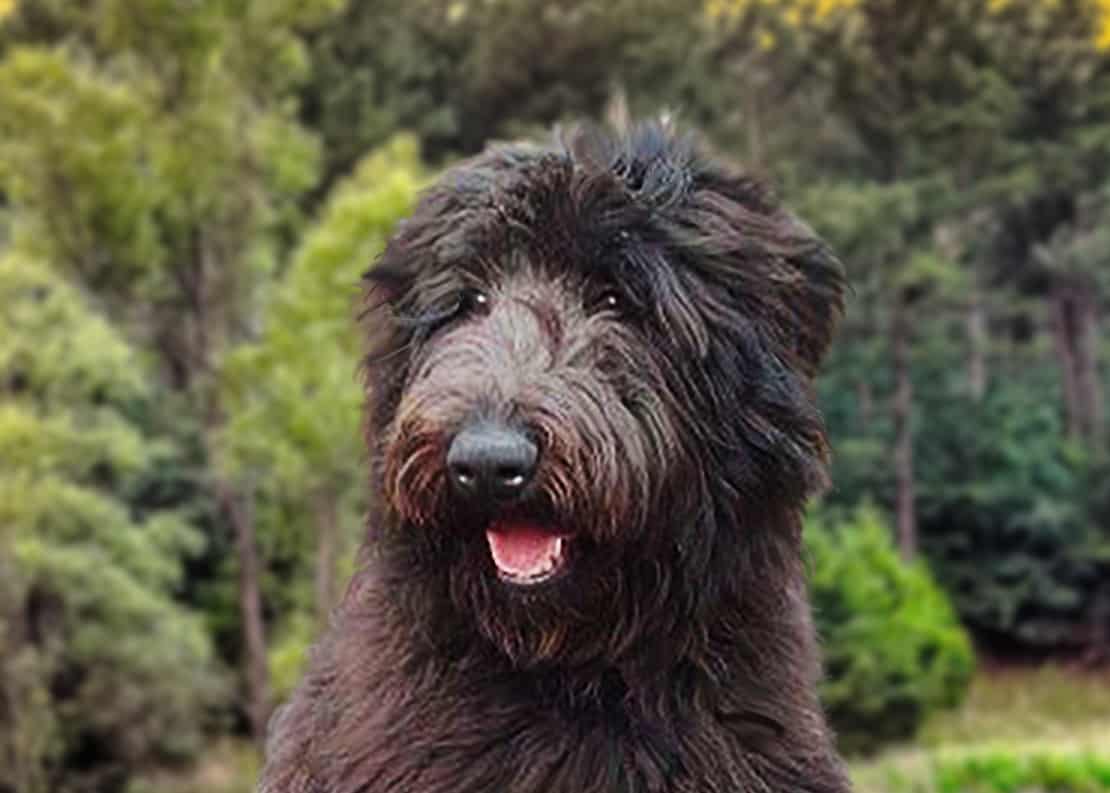Shepadoodle Facts – The German Shepherd Poodle Mix
What is the best dog breed for you and your family members? Of course, the answer depends on what qualities you’re looking for in a great family dog, but if you want intelligent dogs and loyal companions that can keep up with you no matter what your hobbies are, then the Shepadoodle might be perfect! Read on to learn more about this delightful mix of German Shepherd and Poodle.
What is a Shepadoodle?
Shepadoodles are designer dogs that have been bred to have the high intelligence of German Shepherd dogs and the low-shedding (plus extra intelligence) of a Standard Poodle breed. Since both purebred dogs are high on the intelligent dog’s scale, they are excellent as service dogs and easy to train.
Shepadoodles also have a high energy level and need to be kept active, so a yard or some form of running space is a priority.
German Shepherds and Poodles are both recognized by the American Kennel Club, but due to their relatively new status, Shepadoodles are not.
Let’s look at the particulars of the parent breeds :
The Standard Poodle
The standard Poodle is one of the most recognized intelligent dog breeds in the world. The standard Poodle originates from Germany and was bred to be an agile water retriever. The standard Poodle has a curly, waterproof coat that comes in several color combinations like black tricolor, pure white, or solid black or brown.
Scientists have found evidence of dogs similar to the standard poodles living more than 2,000 years ago in Asia and European regions. Standard poodles were developed by crossing standard Pomeranian and Water Spaniel’s with standard poodles as well as German Shepherds, according to Dictionary.com.
The German Shepherd
German Shepherds are one of the large popular dog breeds that originated in Germany and are best known as military police dogs. It was bred as a working dog and is still employed in the majority of police and military roles around the world. Largely thanks to this association, it remains one of the most popular dogs in America.
German Shepherds are relatively intelligent and obedient. Unlike many other breeds, they do not develop separation anxiety when left alone.
In the home, German Shepherds are relatively gentle and calm. Most will tolerate small children without any problems. They are protective of their family but not aggressively so. They are alert dogs that will bark to let you know if they hear an unfamiliar sound.
When trained correctly, German Shepherds make excellent guard dogs. They are used to warn their owners of anything unusual that may be happening.
Poodle and German Shepherd Mix Appearance
Shepadoodles are dogs that look like a cross between a poodle and a German Shepherd. They can either have straight or wavy fur, and it can be thick or dense. Even if the dog looks like the German Shepherd in color, it is not likely to shed as much because of the Poodle genes. Their coats usually include black, sable, cream, tan and gray colors.
Shepadoodle Sizes
How big does a Shepadoodle get? Shepadoodles come in three different sizes: toy, mini and standard A standard size Shepadoodle can grow to be 29 inches tall from head to toe and weigh up to 90 pounds fully grown. 8 week-old puppies weigh about 10 pounds and are considered fully grown at 14 to 18 months.
Standard Shepadoodle Size
- Standard Male Height is 29 inches tall at the shoulder
- Standard Female Height is 28 inches tall at the shoulder
- Standard Full Grown Male Weight is 90 pounds
- Standard Full Grown Female Weight is 90 pounds
Toy Shepadoodle Size
A toy Poodle parent produces the smallest size of Shepadoodles. It takes them only about a year to reach their full adult size.
- Standard Male Height is 15 inches tall at the shoulder
- Standard Female Height is 15 inches tall at the shoulder
- Standard Full Grown Male Weight is 12 to 25 pounds
- Standard Full Grown Female Weight is 10 to 22 pounds
Mini Shepadoodle Size
Miniature Shepadoodles are a miniature Poodle parent product and are a good size because they aren’t too small or too big. They are the happy medium between getting a dog you can easily control and exercise while their size isn’t too small. In general, the larger the size of a dog you get, the more exercise and living space they will need.
- Standard Male Height is 21 inches tall or less at the shoulder
- Standard Female Height is 20 inches tall or less at the shoulder
- Standard Full Grown Male Weight is 22 to 45 pounds
- Standard Full Grown Female Weight is 22 to 45 pounds
Shepadoodle Temperament
The Shepadoodle is a dog that loves to play with children and other pets. They have good personalities and love to be around people. They will bark when they need something, but they do not bark too much.
Don’t be taken in by their quiet nature, because this dog breed makes a good watchdog. They will protect the family without being aggressive and they are always on the lookout for anything suspicious. This active pup does have a playful and energetic nature but it does not need to run every day to get tired. This type of dog is fine with staying inside with their pet parents, but they also like going outside sometimes for exercise and long walks.
Popular Shepadoodle Generations
- F1 Shepadoodle (50% Poodle, 50% German Shepherd)
Both parents are 100% poodle and 100% German shepherd. The F1b will have the most variations in its appearance because it is undetermined which dominant genes prevail at this point.
- F1B Shepadoodle (75% Poodle, 25% German Shepherd)
This cross will likely be more hypoallergenic than the F1 due to the Poodle dominance. A reverse F1b is a Shepadoodle crossed back up to the German Shepherd.
- F2 Shepadoodle (50% Poodle, 50% German Shepherd)
An F2 is the result of crossing two F1 Shepadoodles. This generation will have more consistency in their traits.
- F3 Shepadoodle (50% Poodle, 50% German Shepherd)
An F3 is the result of breeding two F2 Shepadoodles and has a fairly stable and predictable set of genetic traits.
Shepadoodle Health Issues
Some common health problems come with the larger hybrid dog breeds. These should be screened out by a reputable breeder, but it is a good idea to be aware of some of the weaknesses that are a part of the Shepadoodle breed genetic makeup.
The breeder will be able to provide info on such things as parents’ health certificates, genetic testing, and all vaccinations.
Panosteitis
Panosteitis is a disease in dogs that can make it hard to walk around. The periosteum of the bone becomes inflamed and causes pain. Large dog breeds grow rapidly, which makes the condition worse.
Hip Dysplasia /Elbow Dysplasia
Hip dysplasia is a common condition that often affects large and giant breeds of dogs. To understand hip dysplasia, you first have to know about the bones in the dog’s hips. There are two bones called the ball and socket. The ball covers most of the round end of the femur bone and it is where one side of a joint will be. The socket is on top of your dog’s pelvis, at the other end of a joint, where they fit together like a ball in a cup. For some dogs with hip dysplasia, there is not enough space for their ball to fit into their socket or for their sockets to open up all the way so they can move smoothly without grinding against each other.
Pannus
Pannus is an immunologic eye disease characterized by abnormal growth of tissue over the cornea.
Von Willebrand’s Factor
Von Willebrand’s factor is a protein made from several smaller proteins. Von Willebrand’s disease is a blood disorder that happens when there is a problem with one of these proteins. When a blood vessel has tears, platelets clump together to plug up holes and stop the bleeding. When there is something wrong with a body’s von Willebrand’s factor, platelets don’t stick together properly and this causes prolonged bleeding.
Degenerative Myelopathy
Degenerative myelopathy (DM) is a disease affecting the spinal cord, resulting in slowly progressive hind limb weakness and paralysis. It is considered a disease of middle-aged to older dogs including German Shepherds, German Shepherd crosses, Siberian Huskies, and Collies
Gastric Dilatation-Volvulus or GDV
Food and gas can cause the stomach to dilate or expand to the point that neither can be expelled. It can progress to the point where the entire stomach rotates (called volvulus) within the abdomen and restricts blood flow to vital organs.
What is a Shepadoodles Life Expectancy?
The life span of the Shepadoodle mix ranges from 12 to 14 years. Of course, this range depends on their health status and several environmental factors.
Is a Shepadoodle the Right Dog for Me?
The most important thing to think about when you buy a pet is the cost. You have to pay for vet bills, insurance, food, toys, and more. It costs a lot of money! So think about what other costs might happen and how much they will be.
You might need to think about whether you have enough time to care for your dog. You also need to think about vacations. Who will take care of your dog if you go away? Dogs can’t be left alone all day and all night, so someone needs to check in on them.
Shepadoodles need a lot of space to roam. They need space to run around. So if you live in an apartment, this is not the right breed for you. It can be hard for owners who don’t have a lot of activity in their life to take care of them because they will become bored and start chewing on things or barking too much.
Shepadoodles are great companions and give good traits from both a German Shepherd and a Poodle. They are fairly easy to take care of, but you should have time to exercise them enough. You should be exercising your Shepadoodle for at least 1 hour per day. Have plenty of chew toys on hand for indoor mental stimulation.
The downside to having a Shepadoodle is that they need to be regularly brushed and have haircuts, so get that slicker brush ready! The upside is that they shed less than German Shepherds. Also, people with allergies are more likely to be okay with a Shepadoodle if they have animal allergies because of lower shedding from the family’s Poodle side.
Conclusion
If you’re looking for a dog that is loyal, obedient, intelligent, and loving then the Shepadoodle might be just the right fit. The mix of two different breeds produces surprisingly lovable results with an eagerness to please their owners.


